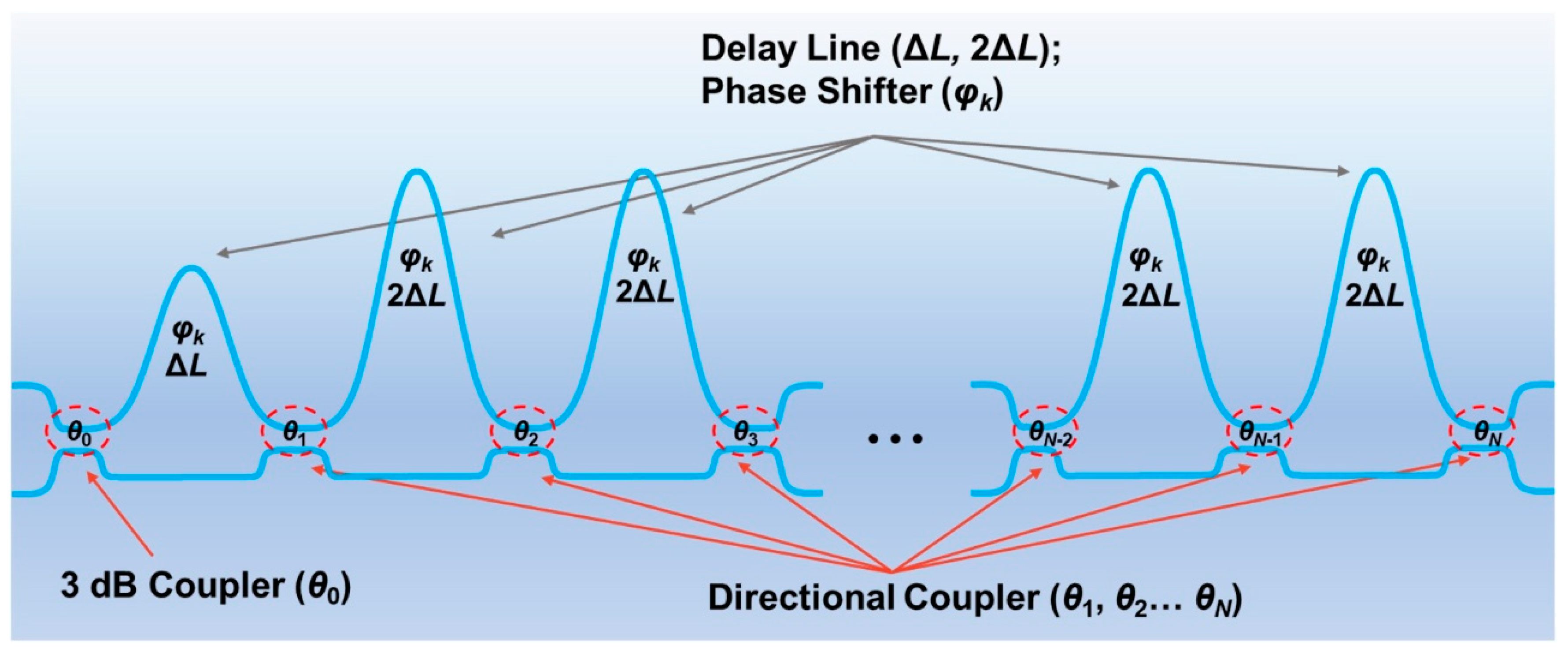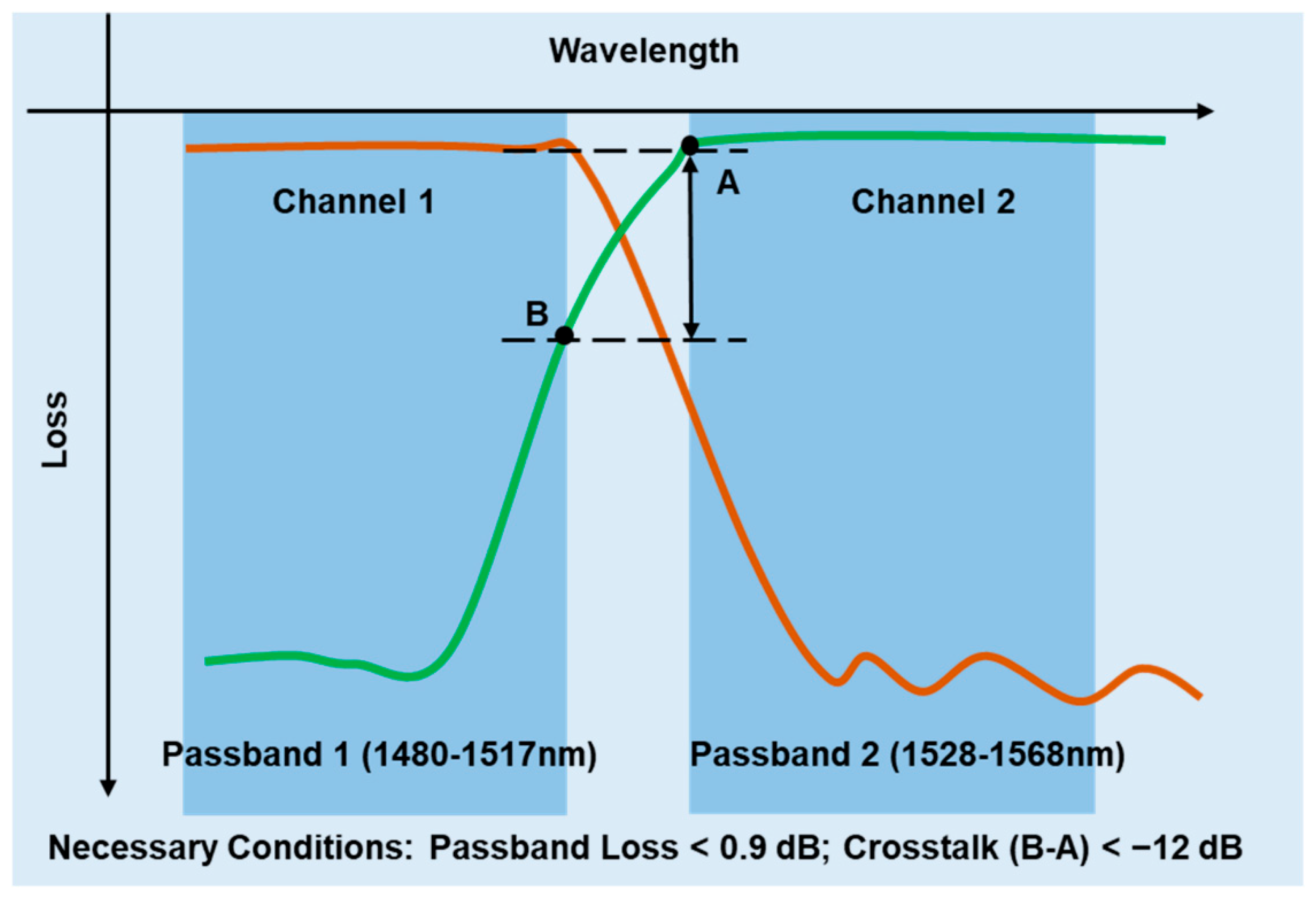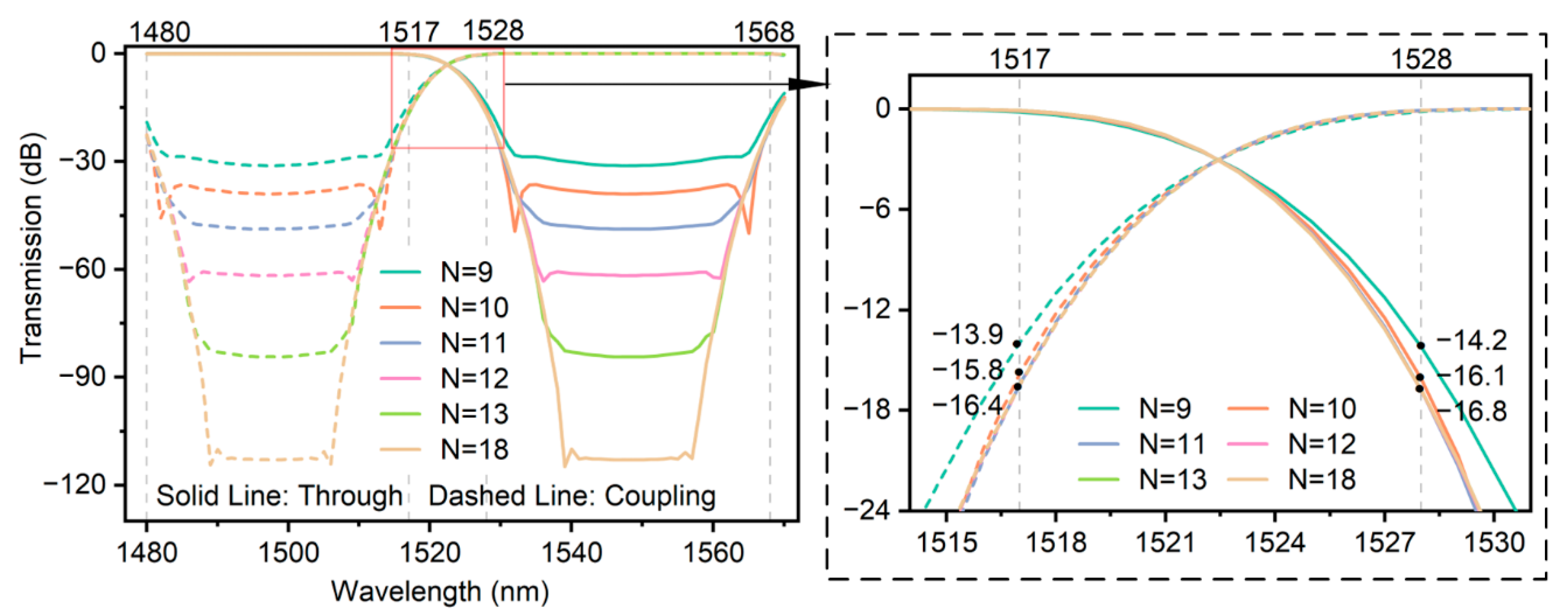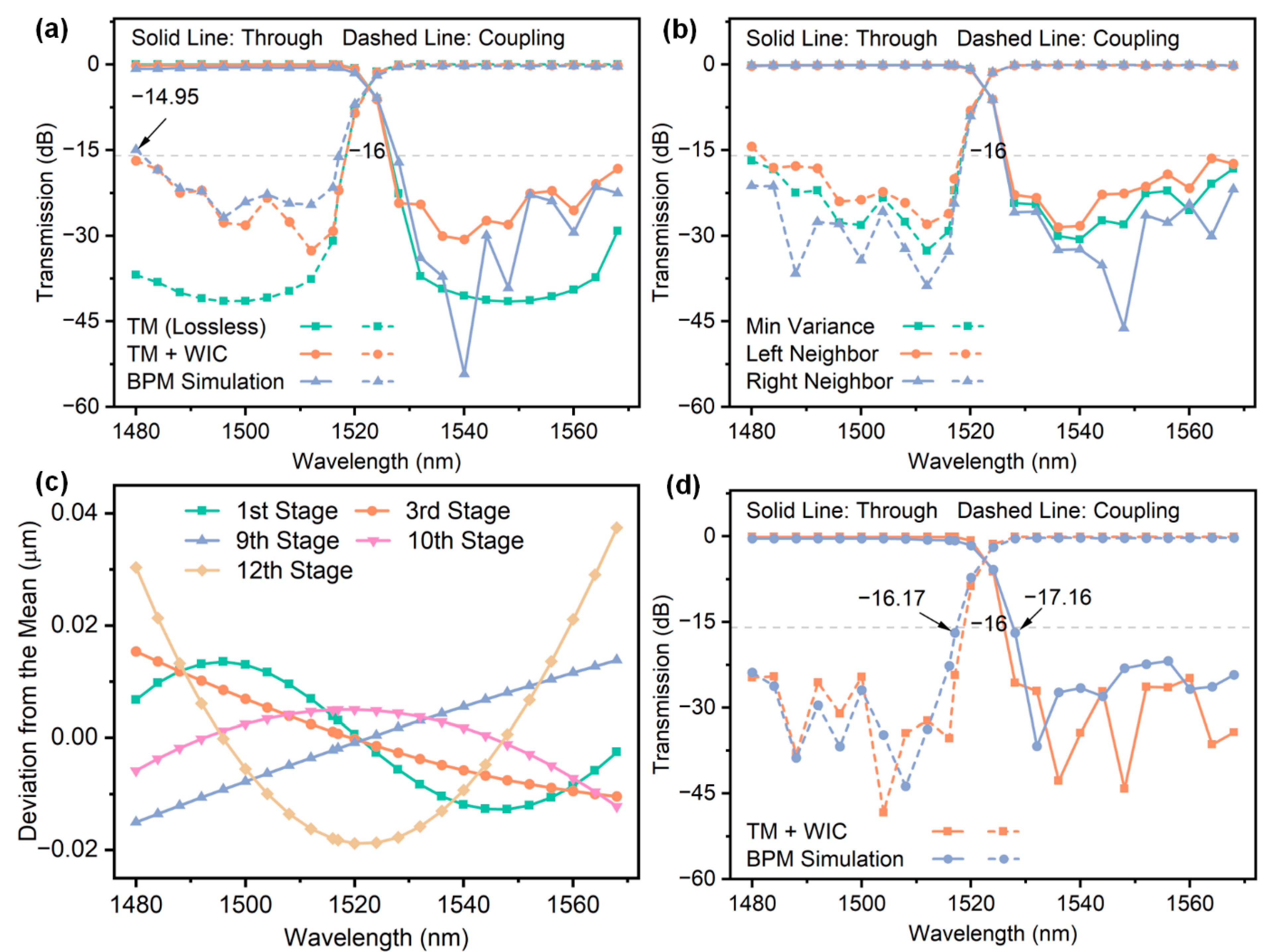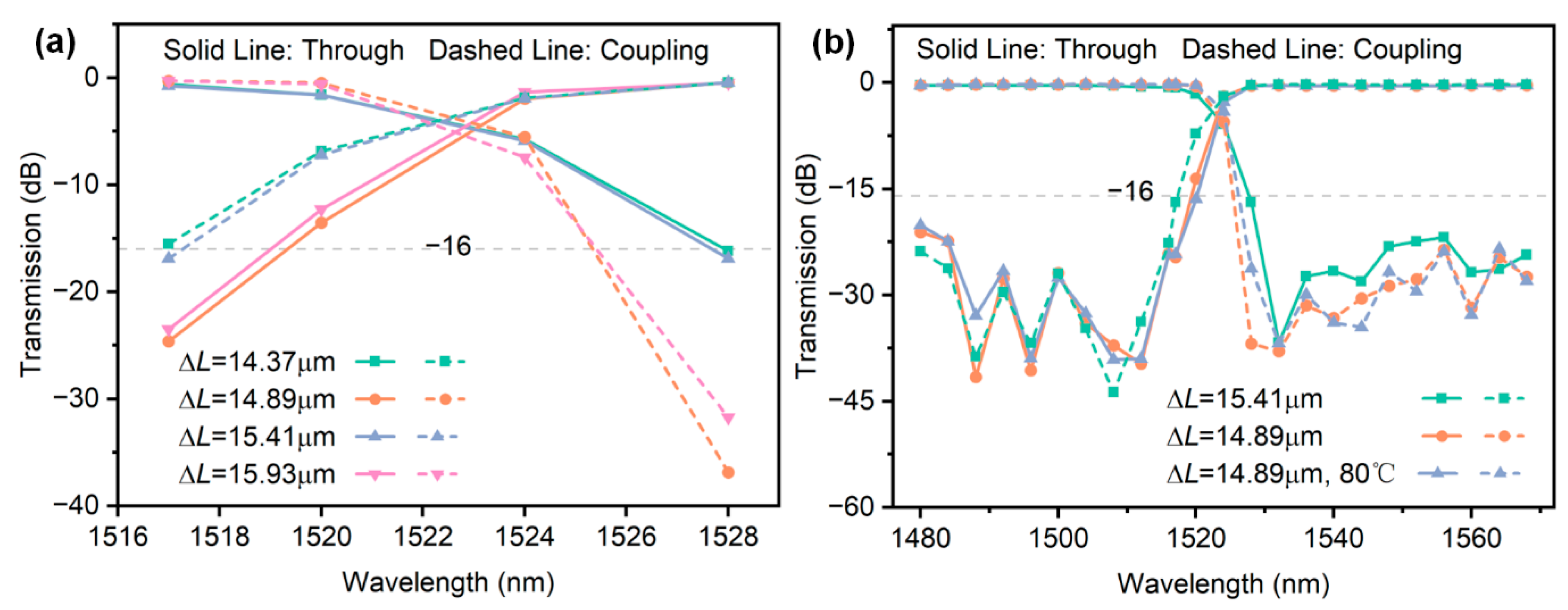3.1. Number of Stages in Cascaded MZIs
The channel spacing between the two filter channels is ∆
λ = 51 nm, and the central wavelength of the filter is
λ0 = 1522.5 nm. The refractive index of the cladding and the core is 1.444 and 1.474, respectively. The relationship between the path length difference (∆
L) of the delay line in the first stage of the cascaded MZI, the channel spacing, and the central wavelength is given as follows:
where
neff is the effective refractive index of the waveguide at the central wavelength, with a value of 1.457. It should be noted that when the dispersion effect is weak, the effective refractive index (
neff) can be used as an approximation of the group index (
ng) to simplify the calculation [
19].
Calculation with Equation (7) yields ∆
L = 15.60 μm as an initial estimate, while the transfer matrix calculation provides a more accurate result of 15.41 μm. This refinement accounts for the approximation error introduced by using the central wavelength in Equation (7). As the number of stages increases, both bands exhibit enhanced flatness within their passband ranges. Theoretical analysis indicates that the cascaded MZI satisfies the design requirements when the number of stages exceeds 11. Considering the inherent transmission loss in cascaded MZIs, it is essential to incorporate a design margin to compensate for attenuation and ensure optimal performance. Verification confirms that with 18 stages, the worst crosstalk occurs at 1517 nm, reaching −16.3 dB (yellow line in
Figure 3). In this case, the phase shift factor is π, rendering it wavelength-independent.
However, designing with the full 18-stage cascaded MZI presents several challenges. In such structures, an
N-stage cascaded MZI contains (
N+1) directional couplers.
Table 1 lists the coupling angles and their corresponding cosine-squared and sine-squared values for the final (
M+1)-th coupler within the first
M stages of the full 18-stage cascaded MZI. In the first 9 stages of the full 18-stage cascaded MZI, the 10th directional coupler exhibits a coupling angle of 0.085 rad, corresponding to cos
2 θ = 0.9928 and sin
2 θ = 0.0072. In the first 12 stages, the 13th directional coupler exhibits a coupling angle of 0.0045 rad (cos
2 θ = 0.9999, sin
2 θ = 0.0001), making it impractical to design a coupler with such an extreme 1:0 power splitting ratio. In the maximally flat half-band filter model by Kaname Jinguji [
15], the coupling angles decrease from the second stage onward, and the approach of zero angles in the final stages renders the design impractical. The analysis of the power spectra for the truncated structures (
Figure 3) shows that crosstalk improves by 2 dB when increasing from the 9-stage to the 10-stage configuration, but only by 0.6 dB from the 10-stage to the 11-stage configuration. Moreover, beyond the 11-stage configuration, the crosstalk values at 1517 nm and 1528 nm converge, indicating diminishing performance gains. Therefore, increasing the number of stages does not effectively improve crosstalk performance and only increases device length. To meet the design requirements, the following three constraints are proposed: (1) The final coupling angle of the cascaded MZI should be no less than 0.02 rad; (2) To minimize layout size, the number of stages is limited to 13; (3) Crosstalk should be less than −16 dB to provide sufficient margin.
Based on these three aforementioned constraints,
Figure 4 illustrates the design of cascaded MZIs that meet the requirements. In
Figure 4, the horizontal axis represents the total number of stages
N in the full cascaded MZI, while the vertical axis in
Figure 4a indicates the coupling angle of the final directional coupler in the first
M stages (
M = 10, 11, 12, 13). It can be observed that as the total number of stages (
N) increases, the corresponding final coupling angle in the truncated structure also increases. Meanwhile,
Figure 4b shows that crosstalk initially improves but eventually worsens as
N grows. If only Condition 1 (coupling angle > 0.02 rad) is considered, all cascaded MZIs above the dashed line in
Figure 4a meet the requirement. Similarly, if only Condition 2 (crosstalk < −16 dB) is considered, all cascaded MZIs below the dashed line in
Figure 4b meet the requirement. However, if both conditions must be satisfied simultaneously, then for a truncated 10-stage cascaded MZI to meet the requirements, it must be derived from a full 21- or 22-stage design; other stage numbers do not satisfy both constraints. Under the constraints of Condition 1 and Condition 2, while increasing the number of stages gradually enhances crosstalk performance, it also leads to a significant increase in device size, necessitating a trade-off between performance and size.
To clearly present the impact of directional couplers on filter performance, a summary of their structural characteristics is provided as follows. First, the coupling angles of the directional couplers vary across stages, as determined by the theoretical model of the maximally flat half-band filter [
15]. In a complete cascaded MZI structure, the first coupler is a 3 dB directional coupler, while the coupling angles of subsequent couplers generally decrease stage by stage. As the number of stages increases, the total number of directional couplers also increases, leading to improved passband flatness and enhanced control over the transition band. However, it should be noted that the later-stage coupling angles may approach zero, significantly increasing the design and fabrication complexity of the couplers. Therefore, the filter design must strike a balance between performance optimization and fabrication feasibility.
The first 11 stages of the full 28-stage cascaded MZI have met the design requirements for the minimum coupling angle and crosstalk, while the crosstalk of the first 13 stages is further reduced to approximately −23 dB. This paper focuses on analyzing the performance of the first 13 stages of the full 28-stage cascaded MZI in
Section 3.2 and compares the BPM simulation results with the theoretical lossless transmission. It should be noted that the maximally flat half-band filter design model proposed by Kaname Jinguji has certain limitations. Specifically, when the total number of stages
N is 14–17 or 19, the crosstalk is approximately −4 dB, which fails to meet the design requirements. Since these issues are beyond the scope of this study, they are not analyzed further in this paper.
3.2. Optimization of Broadband Optical Half-Band Filters
In a cascaded MZI, the coupling ratio of directional couplers varies significantly with wavelength. By replacing directional couplers with an MZI structure and introducing delay lines at both ends, a wavelength-independent coupler (WIC) can be realized, enabling stable coupling ratios over a broadband range while maintaining a 90° output phase difference [
4,
20], as shown in
Figure 5a. In the design of the WIC, the phase compensation values required to maintain a constant 90° output phase difference vary across different wavelengths. When the phase shift introduced by the delay lines equals an integer multiple of 2π, it does not affect the overall phase. Therefore, by comparing the phase deviation variances under different integer-multiple conditions, the group with the minimum variance is selected, and its average value is used as the phase compensation to ensure phase stability across the broadband range.
Figure 5b shows the phase compensation values versus wavelength for the first WIC in the 13-stage cascaded MZI within the minimum variance group. The wavelength range spans from 1480 nm to 1568 nm, with a sampling interval of 4 nm, resulting in 23 sampling points. It can be observed that different wavelengths require different compensation values to maintain the 90° output phase difference. In this case, the average compensation value is 4.18 μm, and the minimum variance is 9.75 × 10
−5.
Figure 5c further illustrates the phase compensation characteristics of the adjacent groups. The lower-adjacent group yields an average compensation of 3.13 μm with a variance of 7.78 × 10
−4, while the upper-adjacent group has an average compensation of 5.23 μm with a variance of 1.39 × 10
−4. Since the 13-stage cascaded MZI contains 14 directional couplers, there are 14 WICs that require phase compensation design.
Figure 6a provides a detailed comparison of the spectral characteristics of the 13-stage cascaded MZI under three conditions: the transfer matrix (TM) method for lossless transmission, the TM method with WIC, and BPM simulation. The green line represents the theoretical spectrum under lossless transmission. Since the coupling ratio of the directional couplers does not vary with wavelength, it achieves the best crosstalk performance. The orange line corresponds to the TM method calculated spectrum with the directional couplers replaced by WIC. Due to the inability of the WIC to maintain constant coupling ratios and phase differences across the entire wavelength range, the crosstalk within the passband exceeds the theoretical value, while slightly above −16 dB at the edges. The blue line shows the spectrum obtained from BPM simulations. At the passband edge, the crosstalk further deteriorates to −14.95 dB at 1480 nm, failing to meet the design requirements. As shown in
Figure 6b, the green line corresponds to the spectrum of the phase compensation value with the minimum variance, which does not yield the optimal spectral performance (all spectra are based on TM+WIC). Among the adjacent phase compensation values of the minimum variance group, the left-adjacent compensation value (orange line) results in slightly worse crosstalk performance, while the right-adjacent compensation value (blue line) achieves better crosstalk performance than the minimum variance group.
This phenomenon is primarily caused by the inherent limitations of using the average value as the delay line phase compensation.
Figure 6c illustrates the difference between the actual phase compensation values of five WICs and their average value in a 13-stage cascaded MZI (note that phase compensation values can be converted to delay line length differences and vice versa). For instance, the green line represents the first WIC difference and exhibits sinusoidal variation with wavelength, while the orange line represents the third WIC difference that decreases monotonically with wavelength. For an individual WIC, the output phase difference is minimized and approaches 90° in the minimum variance group. However, in a cascaded MZI, variations in the differences between actual compensation values and their averages for each WIC across wavelengths cause the phase fluctuations of individual WICs to accumulate gradually, significantly impacting the overall output performance. As shown in
Figure 6c, the average value is approximately centered within the 1480–1568 nm wavelength range, ensuring that the transmission spectrum at the central wavelength aligns more closely with the theoretical results. In contrast, at the band edges, random variations in the differences between actual compensation values and the average lead to the worst crosstalk performance. Therefore, even with the minimum variance group, the transmission spectrum may not achieve optimal performance.
In the 13-stage cascaded MZI, each stage exhibits a phase compensation value with minimum variance, accompanied by slightly higher variance values on either side. This results in a total of 3
13 possible compensation combinations, each generating a set of transmission spectra, from which the optimal combination can be identified by comparing crosstalk performance within the passband. However, with more than 1.5 million possible combinations, exhaustive calculations become too complex and impractical. To address this, a random sampling method is employed that selects a subset of combinations (e.g., 30,000, accounting for 2% of the total combinations) for optimization. Among these random samples, the crosstalk values of the transmission spectra calculated using the TM method reduced significantly from −16.7 dB to −24.3 dB (
Figure 6d). Although the sampled combinations account for only 2% of all possible combinations, the optimized crosstalk performance approaches the theoretical lossless transmission level regardless of the limited sample size. Multiple sampling experiments indicate that the optimized crosstalk value stabilizes around −24 dB, validating the effectiveness of this method. In BPM simulations, the crosstalk at the passband edges is also significantly improved. However, at the two boundary wavelengths of 1517 nm and 1528 nm, the crosstalk remains unoptimized at around −16 dB and requires further investigation and optimization.
The first delay line length difference of the 13-stage cascaded MZI is Δ
L = 15.41 μm; when the phase difference in the delay line undergoes a
π-phase shift, the output spectrum remains unchanged. Specifically, when the delay line length difference changes by Δ
Lmean =
λ0/
Neff = 0.52 μm, the waveforms of the through arm and coupling arm are interchanged. As shown in
Figure 7a, when Δ
L decreases from 15.41 μm to 14.89 μm, the entire transmission spectrum shifts toward shorter wavelengths (blue shift), improving crosstalk at 1517 nm and 1528 nm. Further reducing Δ
L to 14.37 μm causes the crosstalk at 1517 nm and 1528 nm to return to levels comparable to those at Δ
L = 15.41 μm. On the other hand, increasing Δ
L to 15.93 μm also improves the crosstalk at the passband edges. However, as the average value method for adjusting the delay line phase difference fails to induce a
π-phase shift across all wavelengths, further reducing Δ
L increases the channel spacing of the filter and worsens the crosstalk at 1517 nm and 1528 nm. Conversely, increasing Δ
L decreases the channel spacing of the filter, which, in turn, degrades the crosstalk performance at 1480 nm and 1568 nm. Therefore, Δ
L was adjusted from 15.41 μm to 14.89 μm, and BPM simulations were conducted. As shown in
Figure 7b, the final crosstalk was optimized from −16.1 dB to −20.7 dB, while the insertion loss was reduced from 0.75 dB to 0.45 dB.
When using the TM method for calculations, changes in Δ
L do not affect the crosstalk at the passband edges, whereas, for BPM simulations, variations reveal a significant impact of Δ
L on the crosstalk in these regions. Moreover, this phenomenon is not confined to the first 13 stages of the full 28-stage cascaded MZI but is also observed across different numbers of cascaded stages. The most probable explanation is that the derivation of maximally flat half-band filters follows a frequency-division design approach. When mapped to the wavelength domain, this frequency division results in asymmetric bandwidths, especially over a broad wavelength range (1480–1568 nm). This non-uniform distribution in the wavelength domain causes the MZI filter to deviate from the theoretical “ideal flatness” during simulations, affecting the interference conditions of the cascaded MZI and leading to different phase compensation effects for various Δ
L values [
21]. BPM simulations account for the actual interference and dispersion effects of light wave propagation in waveguides, directly incorporating the cumulative errors of light waves in the wavelength domain. As a result, variations in Δ
L have a more pronounced impact on simulations, while the TM method, relying on an idealized model, shows less sensitivity to Δ
L changes and has minimal impact. In summary, BPM simulations performed with the Δ
L = 14.89 μm configuration result in improved crosstalk performance and reduced insertion loss.
To evaluate the thermal stability of the proposed design, additional BPM simulations were performed under the configuration of Δ
L = 14.89 μm by considering the thermo-optic effect of silica materials. According to the experimental results reported in [
22,
23], the thermo-optic coefficients of low-doped silica (used for the core layer) and pure fused silica (used for the cladding layer) are both approximately 1.0 × 10
−5/°C at room temperature, with negligible difference between them. When the ambient temperature increases from 25 °C to 80 °C (a temperature difference of 55 °C), the refractive index increases by approximately 5.5 × 10
−4. The refractive index of the waveguides was accordingly adjusted, and BPM simulations were recalculated. The simulation results are shown in
Figure 6b. At 80 °C, the crosstalk of the 13-stage cascaded MZI slightly degrades from −20.7 dB to −19.7 dB, while the insertion loss remains almost unchanged at 0.45 dB. The filter still maintains acceptable performance under temperature fluctuations, demonstrating good thermal robustness. This further confirms that the cascaded MZI structure on the SiO
2 platform exhibits excellent stability against temperature variations, making it particularly suitable for optical communication systems that do not require strict temperature control.
Table 2 presents the crosstalk comparison for cascaded MZIs with different stage numbers under various calculation methods. The table shows that when Δ
L = 15.41 μm, only the BPM simulation results for the 13-stage cascaded MZI satisfy Condition 3 when ΔL = 15.41 μm. When Δ
L = 14.89 μm, the BPM simulation results moved closer to the theoretical calculations, requiring only 12 stages to meet the condition. Under this configuration, the insertion loss is 0.43 dB, and the crosstalk is −18.8 dB. Additionally, with this configuration, the 13-stage cascaded MZI achieves a roll-off value of 2.2 dB/nm in the transition edge region between 1517 nm and 1528 nm, fully demonstrating the advantage of multi-stage cascaded MZIs in enhancing transition edge sharpness and effectively separating adjacent signals.
Although the primary focus of this study is the theoretical design and simulation analysis of the filter structure, practical engineering factors such as manufacturability, repeatability, and fabrication precision have been carefully considered throughout the design process.
First, the design is based on a SiO2 platform, which offers mature fabrication processes, reliable dimensional control, and low optical losses. This platform has been widely adopted in current photonic integration technologies and ensures high stability and process consistency. To enhance practical feasibility, the minimum coupling angle was limited to 0.02 rad. Extremely small coupling angles lead to power splitting ratios approaching 1:0, which are highly sensitive to fabrication deviations and thus difficult to realize with sufficient accuracy. This constraint improves the design’s robustness against process variations. In addition, to limit structural complexity and footprint, the maximum number of cascaded MZI stages was restricted to 13. This setting ensures adequate bandwidth and passband flatness while preventing excessive chip area and layout challenges. In future work, compact layout strategies such as ring-shaped configurations may be explored to further reduce the footprint.
Compared to other types of integrated optical filters—such as ring resonators [
10], adiabatic couplers [
11], and multimode interference gratings [
24]—the cascaded MZI structure offers clearer design rules and greater flexibility in structural control. While it remains sensitive to fabrication accuracy, its adaptability and integration potential have been demonstrated in prior implementations on both Si [
4] and SiO
2 [
25] platforms. Furthermore, the authors’ group has previously fabricated and tested various devices, such as Y-branch splitters, on the same SiO
2 platform [
26], providing valuable experience and a solid technical foundation for the future experimental validation of the proposed filter structure.
To further highlight the performance advantages of the proposed design,
Table 3 summarizes a performance comparison with several recently reported optical filters based on different structures, considering key metrics such as insertion loss, crosstalk, guard band width, and 3 dB bandwidth of individual channels. Compared with other architectures, vernier microring resonators and multimode waveguide grating filters are generally limited by narrow 3 dB bandwidths, while adiabatically coupled waveguide filters exhibit relatively poor crosstalk suppression. AWG-based filters can support broadband operation but often involve trade-offs between passband width and guard band width. In contrast, the proposed maximally flat half-band filter simultaneously achieves a wide passband bandwidth (40 nm), narrow guard band width (11 nm), and strong crosstalk suppression (below −20 dB), offering a favorable balance among broadband capacity, channel isolation, and spectral utilization.
Future research offers several promising directions, such as the design of long-chain cascaded MZIs in a manufacturable ring-shaped layout, which presents a key challenge [
25,
28]. Such a layout can significantly reduce the device footprint, thereby improving wafer utilization. Additionally, future studies could focus on the optimization of non-half-band cascaded MZIs by flexibly adjusting the parameters of individual couplers and delay lines [
29] to further improve filtering performance at boundary wavelengths. Lastly, for multi-channel filter designs, the hybrid integration of cascaded MZIs with other devices, such as arrayed waveguide gratings (AWGs) or micro-ring resonators [
30], could be explored to achieve higher system integration and greater functional diversity.
